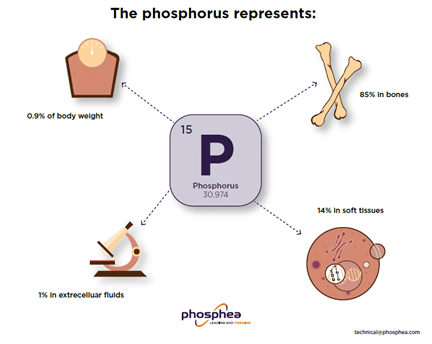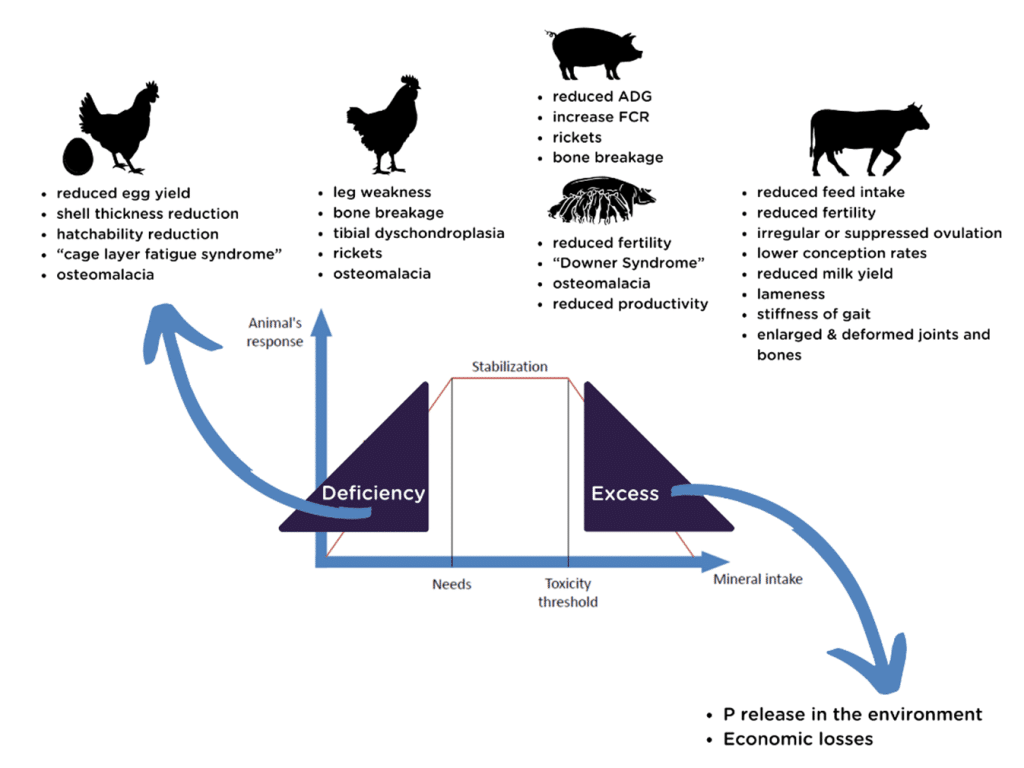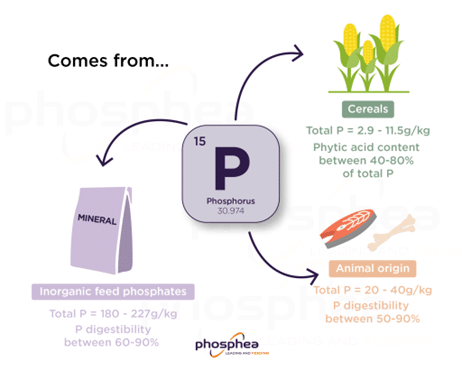Calcium (Ca) and phosphorus (P) are essential raw materials for animal health, performance, and well-being. Ca represents 1.9% of the total body weight and is the basis of the bone structure. P is the 2nd most abundant element in animals’ bodies after Ca. Indeed, it represents 0.9% of the total body weight with 85% of it stored in the bones and the remainder in the body fluids and soft tissues. Indeed, in addition to being present in bones, P is found in DNA and ATP (adenosine triphosphate) molecules that provide the cell’s energy.
Phosphorus what for ?
Major metabolic processes involve P :
- Development & maintenance of skeletal tissue : the greatest proportion of P is devoted to maintaining the skeleton, where it is co-precipitated with Ca in the form of hydroxyapatite. The skeleton acts not only as a support system but also as a reservoir of Ca and P from which the rest of the body can draw, especially during animal pregnancy and lactation and, for hens, during the laying period. P is also essential for the shell’s hardness of crustaceans!
- Energy utilization & transfer : P plays a vital part in energy regulation. Certain phosphates, such as ATP, are universal accumulators and donors of energy. Indeed, they are present in all body cells and ensure both the storage of energy and its utilization. ATP is of prime importance in muscular activity during which chemical energy is converted into mechanical energy.
- Protein synthesis, transport of fatty acids, amino acid exchange : Phosphorylation is responsible for intestinal absorption, glycolysis and direct oxidation of carbohydrates, renal excretion, transport of lipids, exchange of amino acids, etc. P is also a component of many co-enzymes and a constituent of phospholipids allowing the flexibility of cell membranes.
- Growth & cell differentiation (DNA) : P forms part of the structure of nucleic acids, which are carriers of genetic information and regulate protein biosynthesis and immunity.
- And many more !

Figure 1: what does the P represent in the body ?
Did you know ?
Test yourself : Do you know what happens with the P which is not digested by the animals? This is voided in the manure, where it can be used as a cheap natural source of phosphorus next to nitrogen and other minerals. Most of the phosphorus in the manure, however, doesn’t originate from the use of inorganic feed phosphates but, for the greater part (>95%), from undigested plant phosphorus.
Phosphorus balance

Figure 2: P balance in the body
Without an adequate supply of P, an animal will suffer from a P deficiency. In all cases it affects the animal’s physical well-being and economic performance. The initial effect is a fall in blood plasma phosphate levels, followed by the response mechanism of Ca and P being withdrawn from the animal’s bones. Apart from a generally lower resistance to infection, this often results in a loss of appetite and a reduction in live weight gain due to impaired feed efficiency.
In laying hens, maintaining a correct Ca:P ratio is essential to ensure that the skeleton of the bird develops sufficiently to support optimum egg yield. In broilers, bone breakage causes major problems during both production and processing, affecting meat quality; birds developing rickets result in total economic loss. In sows, a P deficiency can lead to a shorter animal life cycle and reduced productivity. In fattening pigs, it can affect meat quality and results in economic loss.
You need to provide the P that match with animal’s needs
P requirements for most animals have been well established through the official nutritional tables (NRC, INRAE, CVB, FEDNA, ARC…). However, translating these into daily allowances is more complicated, considering several factors. These include:
- Variations in the levels of animal performance
- Differences between animal breed and strain
- Variations within a flock or herd
- Variations in the composition of feed material
In providing required levels of P, the primary concerns of the livestock producer are animal welfare and productivity, to ensure the proper development of the animal and the best economic return. In addition, environmental considerations to ensure the lowest possible environmental impact are increasingly being considered. Thus, an adequate supply of P in a form that can be absorbed by the animal is essential to achieve environmental & performance challenges. This is often referred to as biologically “digestible” or “available” phosphorus.

Figure 3: the main sources of phosphorus